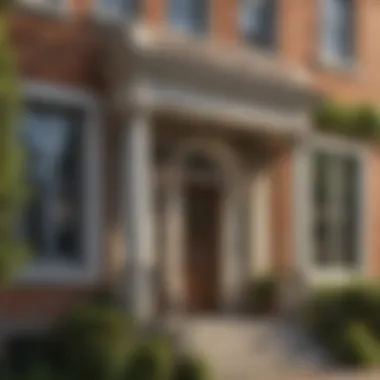Exploring Vibrant Neighborhoods in Washington, D.C.


Intro
Washington, D.C., is not just the capital of the United States; it is a tapestry of diverse neighborhoods, each with its own unique charm and character. This article will explore the various aspects that contribute to the appeal of different areas within the city. From safety and public transportation options to cultural offerings and lifestyle choices, we will unpack the elements that make each neighborhood stand out.
Understanding what defines a good neighborhood is crucial for potential residents. It can shape their living experience and influence their daily lives. With this insights, those looking to settle in D.C. will be better equipped to choose a location that aligns with their preferences and lifestyle.
Featured Homes
Architectural Highlights
Washington, D.C. features a range of architectural styles that reflect its rich history and evolving modern landscape. The classic federal architecture of Georgetown juxtaposes with the contemporary designs found in the recently developed Navy Yard area. These architectural highlights not only enhance the aesthetic of the neighborhoods but also tell the story of the city’s growth and transformation.
Each neighborhood offers something unique:
- Georgetown: Known for its historic rowhouses and cobblestone streets.
- Capitol Hill: Features Victorian homes and is rich in political heritage.
- Dupont Circle: Marked by elegant brownstones and lush parks.
- Navy Yard: Showcases modern multi-family developments and waterfront views.
Interior Design Themes
Interior design within these neighborhoods also varies significantly, influenced by the character and culture of the area. Homes can range from traditional to eclectic.
- Georgetown: Homes here often have period features, with formal rooms and classic decor.
- Logan Circle: Many homes showcase Victorian influences, complete with intricate woodwork and original fireplaces.
- Shaw: A more modern flair, where urban chic meets historical charm.
This variety makes home-hunting in D.C. both exciting and challenging.
Location Spotlights
Cultural Significance
Culture pulsates through Washington, D.C. Different neighborhoods are hubs for art, history, and community. For example, U Street is famous for its music scene and history, once known as the African American Broadway. Adams Morgan offers a vibrant nightlife and dining scene reflecting the diversity of the city.
Natural Wonders
Aside from the urban landscape, Washington, D.C. is home to several parks and green spaces. Rock Creek Park is a significant natural area that offers trails, picnicking spots, and a refuge from the city's hustle. The National Mall serves as both a cultural and recreational space, with monuments and open areas ideal for relaxation.
"D.C. neighborhoods not only provide residences but also foster community engagement through cultural offerings and green spaces."
In closing, exploring neighborhoods in Washington, D.C. reveals a multitude of options that extend beyond mere housing. Each area plays a role in the narrative that is D.C., contributing to the rich experience of living in the capital.
Prelims to Washington, D.C. Neighborhoods
Understanding neighborhoods in Washington, D.C., is crucial for anyone interested in the cultural, social, and economic fabric of the city. With a rich history and diverse population, each neighborhood offers distinct characteristics that appeal to different lifestyles and preferences. These neighborhoods are not just locations to live; they embody a community’s identity, values, and vibrancy.
This article seeks to unpack what makes a good neighborhood in Washington, D.C. Factors such as safety, access to public transportation, and local amenities play significant roles in defining a neighborhood's appeal. Furthermore, the dynamic interplay of residents and their engagement with community resources creates a living environment conducive to growth and stability.
When considering a neighborhood for residence or exploration, it's essential to evaluate several aspects. Accessibility to cultural sites, quality of schools, and the diversity of dining options significantly affect the overall living experience. Understanding these elements can empower individuals to make informed decisions about where to live or invest in the D.C. area.
Defining Good Neighborhoods
Good neighborhoods in Washington, D.C., can be defined through various metrics that contribute to the overall quality of life. Key indicators include:
- Safety: Essential for peace of mind and community trust. High safety standards encourage residents to feel secure in their homes and neighborhoods.
- Amenities: Access to parks, recreational areas, shops, and restaurants enhances daily life, promoting a sense of belonging.
- Education: Proximity to quality schools and educational institutions is crucial for families. It shapes community demographics and influences longevity of residency.
- Transportation: Ease of access to public transit and roadways connects neighborhoods to the broader city, facilitating mobility and access to employment opportunities.
Each of these factors contributes to the desirability of neighborhoods, impacting everything from property values to social interactions among residents.
The Role of Community in Urban Living
Community plays a pivotal role in urban living, especially in a city as diverse as Washington, D.C. Strong community ties can lead to a more enriching and fulfilling experience for residents. A vibrant community fosters:


- Support Networks: Neighbors often provide support to one another, creating a safety net that enhances overall well-being.
- Civic Engagement: Active community participation encourages residents to become involved in local governance, advocacy, and decision-making.
- Cultural Exchange: Diverse neighborhoods facilitate cross-cultural interactions, enriching the lives of residents through shared experiences and understanding.
- Local Business Growth: A supportive community can help local businesses thrive, contributing to the neighborhood's economic stability.
A well-defined sense of community can turn a group of houses into a neighborhood full of life and purpose. Residents who share a connection to their community are more likely to contribute positively, making the area an attractive place to call home.
Historical Overview of D.C. Neighborhoods
Understanding the historical development of neighborhoods in Washington, D.C. is key to grasping their current dynamics and appeal. This historical context provides insight into how communities have evolved over time, contributing to their unique character today. Analyzing the past helps potential residents and enthusiasts appreciate the nuances that shape urban living in the capital.
Neighborhoods in D.C. often reflect larger historical trends, including migration patterns and shifts in political or social climates. Awareness of these aspects influences not only real estate decisions but also cultural engagement and community interactions.
Evolution of Neighborhoods Through History
The transformation of Washington, D.C. neighborhoods can be traced through several distinct periods. Initially, the city was designed to be a planned federal capital, with neighborhoods developing around government buildings and key transportation routes. Over the years, socioeconomic factors and migration trends played significant roles in shaping these neighborhoods.
In the 19th century, the expansion of the city saw the emergence of new residential areas. For example, Georgetown became an important port town. Consequently, it attracted merchants and affluent families. Similarly, the development of Dupont Circle in the late 1800s signified a shift toward urbanization, drawing diverse residents due to its proximity to downtown.
By the mid-20th century, various federal policies impacted the demographic landscape. Neighborhoods like Capitol Hill and Adams Morgan saw changes due to policies that promoted urban renewal. Many communities, particularly in the 1960s and 1970s, faced challenges like disinvestment and socio-economic decline, leading to a complex history of resilience and renewal.
Impact of Federal Policies on Neighborhood Development
Federal policies have historically shaped the development trajectories of Washington, D.C. neighborhoods. Various programs have influenced housing availability and investment, thereby impacting community structure and demographic diversity.
One significant policy was the Federal Housing Administration's (FHA) loan programs post-World War II. These initiatives encouraged suburban expansion but often excluded urban areas from the same benefits, pushing many families out of D.C. neighborhoods. This led to segregation and a decline in some communities.
More recently, policy shifts aimed at revitalization have sought to address previous inequalities. Initiatives such as the New Communities Program focused on improving urban housing and infrastructure. As a result, neighborhoods like Shaw have benefitted from investments in public amenities and housing, promoting re-integration while preserving cultural heritage.
These narratives underscore the importance of understanding both the historical context and the socio-economic implications of urban policy as they continuously mold the diverse neighborhoods that characterize Washington, D.C. today.
Key Considerations When Choosing a Neighborhood
When individuals or families contemplate moving to a new neighborhood in Washington, D.C., they face various critical elements that can determine their overall satisfaction and lifestyle. Understanding these factors can vastly improve the experience of residing in the capital. Good neighborhoods combine safety, affordability, and convenient access to transportation. Therefore, the wise choice of a neighborhood can set the tone for one's daily life.
Safety and Crime Rates
Safety is a paramount concern. It is essential for anyone considering a neighborhood. Crime rates vary considerably between D.C.'s neighborhoods. Areas such as Georgetown often report lower crime rates compared to others, offering residents peace of mind. Evaluating local crime statistics and speaking with residents can give better insights into night-time security and overall safety perceptions. Resources like local police reports or websites that compile crime data can be beneficial when assessing safety. Maintaining a certain level of awareness can enhance one’s sense of security while navigating choices for a neighborhood.
Cost of Living and Housing Affordability
The cost of living is another vital consideration. Washington, D.C. is known for its high housing costs. However, there are neighborhoods that offer more affordable options, such as Anacostia and Shaw, where one might find subsidized housing or lower rent prices. Budgeting for housing, utilities, and everyday expenses is crucial. Potential residents should compare housing prices between various neighborhoods, aligning them with their financial situation. It does make sense to assess additional costs tied to commuting, parking, and amenities too. Investing in a neighborhood with good overall value can contribute to long-term financial health.
Accessibility and Transportation Options
Access to public transportation is invaluable in Washington, D.C. The city boasts a comprehensive metro system. Neighborhoods like Dupont Circle and Navy Yard provide easy access to metro stations, allowing quick commuting to work, school, or leisure activities. The presence of bike lanes and pedestrian-friendly pathways is also crucial. Residents might consider key aspects such as proximity to major roads or highways if driving is their preferred option. Evaluating the overall accessibility can significantly impact the lifestyle one can enjoy in a particular neighborhood. In urban planning, options that facilitate mobility can enhance community interactions and individual experiences.
A neighborhood's appeal is not merely the sum of its features, but how these features cater to the lifestyle aspirations of its residents.
In summary, choosing a neighborhood involves a careful assessment of safety, cost of living, and transportation accessibility. Each element plays a role in shaping the overall quality of life. Prospective residents need to prioritize what aspects are most crucial for them to ensure that their living experience aligns with their needs and expectations.
Prominent Neighborhoods in Washington, D.C.
Prominent neighborhoods in Washington, D.C., offer a glimpse into the city's diverse character and history. Each neighborhood carries its unique atmosphere, making them essential points of interest for residents and visitors alike. Understanding these neighborhoods is crucial for anyone considering a move to the area or simply exploring D.C.'s rich culture.
The benefits of exploring these neighborhoods include access to various amenities, cultural experiences, and historical significance. Moreover, they reflect the city's evolving demographics and the lifestyle options offered in D.C. Whether looking for charm, vibrancy, or political significance, these neighborhoods present a blend of features that cater to different preferences.
Georgetown: Charm and History
Georgetown is one of the oldest neighborhoods in Washington, D.C. This area is known for its picturesque streets and historic row houses. As a former industrial port, it has transformed into a vibrant community with an affluent residential feel. The historic charm of Georgetown is evident in its well-preserved architecture and cobblestone streets.
Georgetown also hosts several popular shops, cafes, and restaurants. The waterfront is a popular destination for both locals and tourists, offering scenic views along the Potomac River. Furthermore, the neighborhood is home to several universities, including Georgetown University, contributing to its dynamic atmosphere.


Dupont Circle: Cultural Hub
Dupont Circle stands as a cultural doorstep to many of D.C.'s attractions. Known for its lively atmosphere, Dupont Circle serves as a gathering place for residents and visitors. The area showcases an array of art galleries, bookstores, and restaurants that promote local culture.
The Dupont Circle Farmers Market is a key highlight. Here, fresh produce and local goods are offered weekly, attracting a diverse crowd. The neighborhood's architectural significance is apparent, featuring grand historic mansions and museums. This blend of culture and community makes Dupont Circle a must-see.
Capitol Hill: Political Significance
Capitol Hill is not just a neighborhood; it is the heart of American politics. Home to the U.S. Capitol and the Supreme Court, this area is essential for understanding the political landscape of the nation. The architecture seen here is imposing yet charming, with Victorian-era homes lining the streets.
The proximity to major governmental institutions affects daily life in this neighborhood. Residents often experience a unique blend of security and engagement in civic activities. Additionally, Capitol Hill's vibrant community includes parks, shops, and eateries, providing a lively atmosphere amidst its political importance.
Adams Morgan: Diversity and Vibrancy
Adams Morgan is renowned for its cultural diversity and vibrant nightlife. This neighborhood showcases a mix of ethnicities and cultures, which is reflected in its restaurants and festivals. The area's eclectic vibe attracts a younger crowd, making it a popular social hub.
Colorful murals and street art add to the artistic flair of Adams Morgan. The neighborhood is also known for music venues and lively bars, offering a variety of entertainment options. This lively environment makes it an appealing choice for those seeking both diversity and vibrancy in urban living.
Logan Circle: Victorian Elegance
Logan Circle is characterized by its beautiful Victorian architecture and lush park. It offers an inviting atmosphere that attracts families and professionals alike. The circular park at the center serves as a focal point for community events and relaxation. Admirable homes line the streets, showcasing the elegance of the era. This neighborhood has a strong sense of community with various local businesses, from boutique stores to cafes, enhancing the overall charm. The appeal of Logan Circle lies in its combination of historic beauty and modern conveniences.
"Each neighborhood in Washington, D.C., is characterized by its unique features that contribute to the overall urban landscape."
In summary, the prominent neighborhoods of Washington, D.C., each offer distinct elements that contribute to the city’s rich tapestry. From the historical significance of Georgetown to the cultural vibrancy of Adams Morgan, these neighborhoods provide invaluable insights into life in the capital.
Emerging Neighborhoods to Consider
Exploring emerging neighborhoods in Washington, D.C. offers a glimpse into the city's evolving urban landscape. As demographic trends shift and investment opportunities arise, these neighborhoods present potential for growth and innovation. Residents and investors alike are drawn to these areas for their affordability, community-driven initiatives, and unique cultural dynamics. Understanding these neighborhoods can provide valuable insights for those looking for vibrant locales within D.C.
Shaw: A Blend of History and Modernity
Shaw is a neighborhood that beautifully contrasts its rich history with modern development. Once a hub for African American culture, this area has seen significant revitalization in recent years. Historic buildings have been restored alongside new construction, creating a diverse atmosphere.
Key features of Shaw include:
- Cultural Institutions: The historic Howard Theatre continues to serve as a venue for performing arts, attracting diverse audiences.
- Culinary Scene: Restaurants like "The Red Hen" and "Shaw's Tavern" offer local flavors, contributing to Shaw's reputation as a destination for food enthusiasts.
- Public Transport: With access to the Green and Yellow Metro lines, residents can easily reach other parts of the city.
Shaw exemplifies how neighborhoods can honor their past while embracing the future, inviting residents who value both heritage and innovation.
Navy Yard: Waterfront Living
Navy Yard is redefining urban living with its scenic waterfront properties and vibrant community feel. Nestled along the Anacostia River, this neighborhood boasts beautiful parks and recreational areas, perfect for outdoor enthusiasts.
Highlights of Navy Yard include:
- The Yards Park: This urban park features waterfront views and event spaces, catering to both relaxation and community activities.
- Dining Options: With eateries like "Bluejacket Brewery" and "The Anthem," dining becomes a social experience, further enhancing the neighborhood's appeal.
- Sports Opportunities: Proximity to Nationals Park allows residents to enjoy live baseball games, fostering a sense of community among sports fans.
Navy Yard presents an attractive option for those looking to embrace an active lifestyle while enjoying waterfront views in a burgeoning urban environment.
Anacostia: Cultural Renaissance
Anacostia is experiencing a cultural renaissance, making it an interesting neighborhood to watch. While historically underserved, recent investments in arts and community initiatives are transforming this area.
Important aspects of Anacostia include:
- Art Scene: The Anacostia Community Museum, part of the Smithsonian Institution, explores African American culture and history, providing residents with a sense of identity and belonging.
- Community Development: Initiatives promoting local entrepreneurs show a commitment to economic diversity and growth.
- Affordability: Compared to other D.C. neighborhoods, Anacostia offers more affordable housing options, attracting new residents seeking value.


Anacostia's evolution into a vibrant community illustrates the potential for neighborhoods to revitalize while promoting cultural values.
"Emerging neighborhoods often reflect the city's overall character, embodying both change and continuity."
In summary, exploring these emerging neighborhoods in Washington, D.C. presents opportunities for new living experiences and investments. These areas blend history with modern amenities, providing rich cultural tapestries for residents to enjoy.
Local Amenities That Enhance Neighborhood Appeal
Understanding the role of local amenities is crucial when evaluating the appeal of neighborhoods in Washington, D.C. Amenities can fundamentally influence the quality of life residents experience. Factors such as parks, shops, restaurants, and cultural institutions serve as essential components that not only enhance individual living conditions but also contribute to the overall community vibe. Finding a neighborhood that offers a rich array of amenities is often what separates a good neighborhood from a mediocre one.
Parks and Recreational Areas
Parks and recreational areas play a significant role in urban living. They provide vital green spaces that contribute to physical health and mental well-being. In a city where concrete dominates, parks serve as an oasis. For instance, Rock Creek Park spans over 1,754 acres and offers various trails, picnic spots, and natural beauty, making it a cherished spot for both locals and visitors. Besides providing a place for leisure activities such as jogging, biking, and dog-walking, parks encourage community engagement through events like outdoor concerts and fitness classes. The presence of well-maintained parks can significantly raise property values and attract families looking for a balanced lifestyle.
Shopping and Dining Options
Access to shopping and dining is another crucial aspect that enhances neighborhood appeal. Areas like Dupont Circle are known for their diverse culinary scenes and eclectic shops, making them vibrant places to live. The availability of grocery stores, specialty markets, and gourmet restaurants ensures that residents have convenient access to daily needs and social activities. This is particularly important for those who value culinary experiences and unique local businesses over chain establishments. Moreover, neighborhoods with bustling shopping districts tend to foster a sense of community, as regular patrons become familiar faces. By prioritizing local businesses, neighborhoods can cultivate a unique character that stands apart from other regions.
Cultural Institutions and Events
Cultural institutions add depth and richness to neighborhood life. Museums, galleries, and theaters attract residents and visitors alike. For example, the Smithsonian museums provide free access to art, culture, and history, impacting the community positively. Cultural events, from art walks to seasonal fairs, bring people together and foster a sense of belonging. The presence of such institutions often reflects a neighborhood's commitment to supporting arts and culture, which can be appealing to those who prioritize creativity in their lives. These amenities not only enrich personal leisure time but also create opportunities for education and community building.
"A neighborhood with ample amenities invites a lifestyle of engagement and connection."
The Future of Neighborhood Development in D.C.
The ongoing transformation of neighborhoods in Washington, D.C. reflects broader urban trends, social dynamics, and economic strategies that shape the city's future. As D.C. continues to adapt to the needs of its residents, understanding the future of neighborhood development becomes essential for potential homebuyers, investors, and urban planners. These developments are not only crucial for maintaining a vibrant community but also play a significant role in socio-economic factors, sustainability, and the preservation of culture.
Urban Trends and Gentrification
Gentrification remains a contentious yet pivotal trend in Washington, D.C. neighborhoods. As affluent individuals move into historically lower-income areas, property values increase, resulting in both positive and negative impacts. On one side, the influx of new businesses and amenities boosts the local economy, creating opportunities for existing residents. However, it also risks displacing long-time residents, causing friction within the community.
Here are some critical points regarding gentrification in D.C.:
- Economic Opportunities: New businesses often lead to job creation.
- Community Tensions: Long-time residents may feel marginalized or pushed out.
- Cultural Shift: Changing demographics can alter the cultural fabric of neighborhoods.
A balanced approach is necessary to harmonize development with community needs. Policymakers have begun to create frameworks that encourage inclusive growth and support affordable housing initiatives. This is vital for ensuring that the benefits of urban renewal extend to all residents, preserving the city's rich history while accommodating its dynamic future.
Sustainability and Green Initiatives
Sustainability is becoming an integral part of neighborhood development in D.C. As urban areas face the impacts of climate change, there is a growing emphasis on green initiatives. Enhancing the livability of neighborhoods through eco-friendly practices is seen as essential for both current residents and future generations.
Key aspects of sustainability initiatives in D.C. include:
- Green Spaces: Parks and community gardens improve air quality and provide recreational spaces.
- Energy Efficiency: New building codes enforce sustainable construction methods and the use of renewable energy sources.
- Public Transit Expansion: Improved public transportation reduces reliance on cars, lessening traffic congestion and pollution.
"Sustainable neighborhood development is not merely about green architecture; it reflects a vision for a harmonious urban environment."
The outcomes of these initiatives contribute positively to the health and happiness of residents. By investing in sustainability, Washington, D.C. sets a precedent for other urban areas looking to integrate similar practices.
In summary, the future of neighborhood development in D.C. hinges on balancing gentrification with inclusivity and prioritizing sustainability. As dynamics evolve, keeping these considerations in mind will not only shape the city’s landscape but also reinforce its position as a leader in urban development.
Finale
The conclusion section serves as a crucial component of this article, bringing together the diverse themes and insights discussed throughout. It emphasizes the complexities that define Washington, D.C.'s neighborhoods and the multifaceted nature of urban living within the capital. This part consolidates the readers' understanding of what makes a neighborhood appealing beyond just aesthetics, highlighting safety, community engagement, and local amenities.
Reflecting on D.C.'s Neighborhood Landscape
As we reflect on the neighborhood landscape of Washington, D.C., it becomes evident that each area possesses unique features and characteristics. Residents and potential newcomers alike must consider these factors when choosing where to live.
Factors such as community involvement, safety metrics, and the availability of public services directly impact the lifestyle of its inhabitants. With rising interest in neighborhoods like Shaw and Navy Yard, the dynamics of urban dwellings continue to evolve, demonstrating a blend of historical significance and modern convenience.
Furthermore, the interplay between culture and daily life finds its expression in events, local eateries, and recreational spaces that enhance community bonds.
"The neighborhoods in D.C. serve not only as residential enclaves but also as living extensions of art, history, and diverse experiences that shape urban identity."







